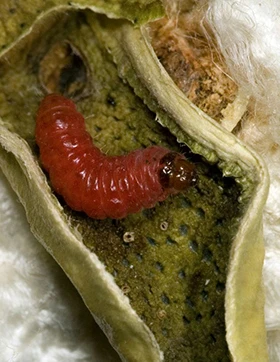
 From the University of Arizona UA News:
From the University of Arizona UA News:
Photo: A pink bollworm caterpillar emerges after devouring the seeds within a cotton boll. This devastating pest quickly evolved resistance to genetically modified cotton in India, but not in the Southwestern United States where a coordinated resistance management program has been in place since the biotech crop was introduced in 1996. (Photo: Alex Yelich/The University of Arizona)
Since 1996, farmers worldwide have planted more than 1 billion acres (400 million hectares) of genetically modified corn and cotton that produce insecticidal proteins from the bacterium Bacillus thuringiensis, or Bt for short.
Latest from Produce Grower
- Mind matters
- John Bonner focuses on purposeful progress as founder of Great Lakes Growers
- The Growth Industry Episode 1: State of the Horticulture Industry
- FDA to Hold Webinar on Updated ‘Healthy’ Claim
- VIDEO: Growing media for strawberries grown under different production systems
- Eden Green Technology CEO Eddy Badrina reflects on challenges, opportunities for CEA
- Why CEA businesses should track carbon KPIs
- UGA professor Erich Schoeller to discuss IPM best practices for CEA at Indoor Ag-Con 2025





